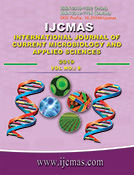


 National Academy of Agricultural Sciences (NAAS)
National Academy of Agricultural Sciences (NAAS)

|
PRINT ISSN : 2319-7692
Online ISSN : 2319-7706 Issues : 12 per year Publisher : Excellent Publishers Email : editorijcmas@gmail.com / submit@ijcmas.com Editor-in-chief: Dr.M.Prakash Index Copernicus ICV 2018: 95.39 NAAS RATING 2020: 5.38 |
Cereals are the member of grasses, which belong to family Gramineae (Poaceae) and cultivated for edible components of their grain which is composed of the endosperm, germ and bran. Cereal grains are grown in greater quantities and provide more food energy worldwide than any other type of crop. In their natural form, they are a rich source of carbohydrates, protein, vitamins, minerals and fats. The green revolution of the 1970s resulted in remarkable increases in rice production. Since then the rate of production in most rice growing countries has slowed and has now reached a plateau. Contributing factor include a higher population growth rate and the conversion of some highly productive rice land for industrial and residential purpose. Millions of hectares in the humid regions of south and Southeast Asia are technically suited for rice production but are technically suited for rice production but are left uncultivated or are grown with very low yields because of salinity and abiotic stresses. Many research findings revels that System of Rice Intensification followed by 120 kg Nitrogen ha-1 has significantly perform better than all others planting system & levels of nitrogen for various growth, yield & quality attributes viz; Number of effective tillers hill–1 (18.59), Number of grains panicle–1 (108.88), Length of panicle (27.90 cm), Test weight (24.82 g), Grain yield (5.34 t ha–1), Straw yield (10.26 t ha–1), Harvest index (34.23 %) and Protein content (8.37 %). While the same combination also found prominent to obtain highest gross return (152600.00 Rs ha–1), net return (92077.92 Rs ha–1) and B: C ratio (2.52) respectively. This review article throws light on some important aspects on influence of different planting system and graded levels of nitrogen on growth, yield, quality and economics of rice (Oryza sativa L.). References from various research articles and literature were compiled systematically with respect to the topic. Evidence based research studies were also reviewed in this regard.
 |
 |
 |
 |
 |